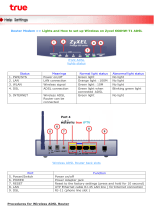
1
Table of Contents
Specification................................................................Error! Bookmark not defined.
Package Contents...................................................................................................... 5
Hardware Connecting................................................................................................. 6
LED Indicators............................................................................................................ 7
General Setting........................................................................................................... 8
Advanced Setup....................................................................................................... 12
Setup................................................................................................................. 12
LAN Setup.................................................................................................. 12
LAN Configuration...................................................................................... 12
Ethernet Switch.......................................................................................... 14
WAN Setup................................................................................................. 15
New Connection......................................................................................... 15
PPPoE Settings................................................................................... 18
PPPoA Settings................................................................................... 20
Static Settings ..................................................................................... 22
DHCP Settings.................................................................................... 23
Bridge Settings.................................................................................... 24
CLIP Settings ...................................................................................... 25
Modem....................................................................................................... 26
ADVANCED....................................................................................................... 27
UPnP.......................................................................................................... 27
SNTP.......................................................................................................... 28
Port Forwarding.......................................................................................... 29
DMZ ........................................................................................................... 30
Custom Port Forwarding ............................................................................ 31
IP Filter....................................................................................................... 32
Custom IP Filters........................................................................................ 32
LAN Clients ................................................................................................ 34
LAN Isolation.................................................Error! Bookmark not defined.
TR-068 WAN Access.....................................Error! Bookmark not defined.
Bridge Filters.................................................Error! Bookmark not defined.
Dynamic DNS Client................................................................................... 35
IGMP Proxy................................................................................................ 36
Static Routing............................................................................................. 37
Policy Routing ...............................................Error! Bookmark not defined.
Ingress ..........................................................Error! Bookmark not defined.





















